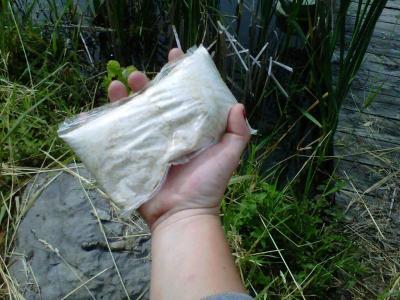With Autumn upon us in Central and Western New York, pond owners face unique challenges in maintaining their aquatic ecosystems. Among the many factors to consider during fall pond maintenance, the role of beneficial bacteria stands out as a key element in preserving pond health. These bacterial microscopic helpers play a vital part in maintaining water quality and supporting the overall balance of your pond ecosystem as it prepares for the colder months ahead.
Understanding Beneficial Bacteria in Pond Ecosystems
 Beneficial bacteria are naturally occurring microorganisms that form an essential component of any healthy pond ecosystem. These tiny workhorses perform a variety of functions that contribute to water quality and the well-being of fish and plants. In the context of pond maintenance, we primarily focus on two types of beneficial bacteria: nitrifying bacteria and heterotrophic bacteria.
Beneficial bacteria are naturally occurring microorganisms that form an essential component of any healthy pond ecosystem. These tiny workhorses perform a variety of functions that contribute to water quality and the well-being of fish and plants. In the context of pond maintenance, we primarily focus on two types of beneficial bacteria: nitrifying bacteria and heterotrophic bacteria.
Nitrifying bacteria are responsible for breaking down harmful ammonia, a byproduct of fish waste and decaying organic matter, into less toxic nitrites and eventually into nitrates, which serve as nutrients for plants. Heterotrophic bacteria, on the other hand, decompose organic debris such as fallen leaves, dead plant material, and fish waste, helping to keep the pond clean and reducing the buildup of sludge at the bottom.
The Changing Dynamics of Fall Pond Maintenance
As summer transitions into fall, the role of beneficial bacteria becomes increasingly important. The falling leaves and cooling temperatures bring about changes in your pond’s ecosystem that require special attention.
During autumn, ponds in Central New York experience an influx of organic matter as leaves fall from surrounding trees. This increase in organic debris can lead to a spike in nutrient levels, potentially causing water quality issues if not properly managed. Additionally, as water temperatures cool, the metabolism of fish slows down, resulting in less waste production but also reduced appetite for food.
Beneficial bacteria play a critical role in managing these seasonal changes. They help break down the excess organic matter, preventing it from decomposing and releasing harmful substances into the water. This process is essential for maintaining water clarity and preventing the buildup of toxic compounds that could harm fish and other aquatic life.
Enhancing the Role of Beneficial Bacteria in Fall
To maximize the benefits of these helpful microorganisms during fall pond maintenance, pond owners can take several steps to support and enhance their populations.
First, consider adding a high-quality bacterial supplement to your pond. These products contain concentrated forms of beneficial bacteria specifically chosen for their ability to thrive in pond environments. Regular additions of these supplements can help boost the existing bacterial population, ensuring that your pond has enough of these microscopic helpers to manage the increased organic load of fall.
It’s also important to maintain good water circulation and oxygenation. Beneficial bacteria require oxygen to function effectively, so using aerators or fountains can help create an environment where these bacteria can thrive. This is particularly important as water temperatures cool and natural circulation decreases.
Removing excess debris from the pond surface can also aid beneficial bacteria. While these microorganisms are excellent at breaking down organic matter, overwhelming them with too much debris can lead to water quality issues. Regular skimming of leaves and other floating debris helps manage the workload for your bacterial helpers.
The Impact of Beneficial Bacteria on Winter Preparation
The role of beneficial bacteria extends beyond just fall maintenance; it’s also a critical factor in preparing your pond for winter. As temperatures continue to drop, the activity of these bacteria will slow down, but their work during the fall months sets the stage for a healthier pond throughout the winter.
By efficiently breaking down organic matter during the fall, beneficial bacteria help reduce the amount of decomposing material left in the pond over winter. This is important because, under the ice, decomposition can continue to occur, potentially leading to a buildup of harmful gases. A cleaner pond bottom, thanks to the work of beneficial bacteria in the fall, means a safer environment for overwintering fish.
Moreover, the nutrients processed by beneficial bacteria during the fall become food for plants and algae. This natural fertilization process helps maintain a balance in the pond ecosystem, supporting plant life that will be essential for oxygenation and filtration when spring arrives.
Long-term Benefits of Supporting Beneficial Bacteria
Recognizing and supporting the role of beneficial bacteria in fall pond maintenance yields benefits that extend far beyond the autumn season. By fostering a healthy bacterial population, pond owners in Central New York can enjoy clearer water, healthier fish, and more vibrant plant life year-round.
These microscopic allies contribute to a more stable and resilient pond ecosystem, capable of handling the stresses of changing seasons and unexpected environmental challenges. They reduce the need for harsh chemical treatments, promoting a more natural and sustainable approach to pond care.
Furthermore, a well-maintained bacterial population can lead to less intensive spring maintenance. With fewer accumulated nutrients and less organic debris, ponds are less likely to experience algae blooms or water quality issues when temperatures begin to rise.
In conclusion, the role of beneficial bacteria in fall pond maintenance cannot be overstated. These tiny yet powerful organisms are key players in preserving the health and beauty of your pond as it transitions through the seasons. By understanding and supporting their function, pond owners in Central New York can ensure their aquatic ecosystems remain vibrant and healthy, ready to face the challenges of winter and emerge strong in the spring. Remember, a healthy pond is a balanced ecosystem, and beneficial bacteria are at the heart of maintaining that balance.
